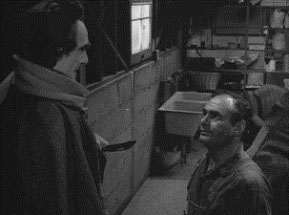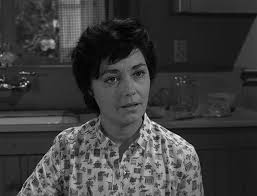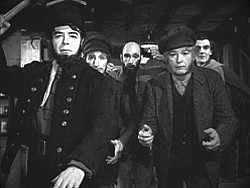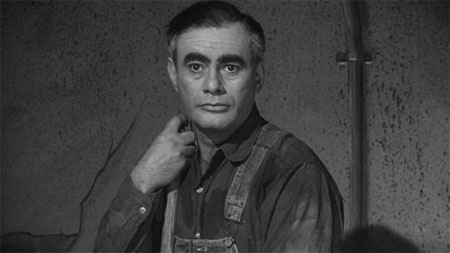Resident Evil: A Second Look at "The New Exhibit"
by Michael Martin DeSapioWhen Twilight Zone fans discuss the hour-long episodes of the series' fourth season (1962-63), "The New Exhibit" is one of the few episodes often mentioned. Written by Jerry Sohl (though credited to Charles Beaumont) and directed by John Brahm, "The New Exhibit" takes the genre of the wax-museum horror story and raises it to the level of a profound psychological study. By tracing the tragic downfall of an ordinary man who falls prey to an unhealthy obsession, the episode delivers a pungent warning about evil and our attitude toward it. And it does so with a good deal of style, thanks to Gothic director Brahm and aided by the superlative acting talent of Martin Balsam in the lead role of Martin Senescu.
Despite being an hour-long episode, "The New Exhibit" has a simple plot. Martin Lombard Senescu (the Romanian surname reminds us of vampires and the macabre as well as "senescence" and "senile") is curator of the Murderers Row exhibit in Ferguson's Wax Museum. After Mr. Ferguson announces that he is abandoning the museum, Martin persuades him to let him keep the figures for a while. When Martin's wife, Emma, tries to destroy the figures, a murderous rampage is unleashed that ends in the deaths of Emma, Emma's brother Dave, Mr. Ferguson, and finally Martin himself. In the final moments of the episode, we see that Martin has himself become memorialized as a wax statue.

The episode opens on an ordinary working day at Ferguson's Wax Museum. After telling a group of visitors about Cleopatra and Marc Antony, Mr. Ferguson hands the reins to Martin, who begins his tour, a tour he has given countless times. Martin introduces the figures of Albert W. Hicks (a sailor who axed his crew mates to death), Burke and Hare (a murdering team who suffocated their victims), Henri Desire Landru (strangler of widows and spinsters), and the notorious Jack the Ripper. In his speech Martin reveals the reasonable-sounding relativism which colors his attitude toward these murderers:
"Surely it is horrible to be murdered, as our poor victim here would tell you (if she could talk). But to murder, to take a life with your hands again and again and not be able to stop oneself--can you begin to imagine the horror of that?"
During the tour sequence, we hear soft organ music--Bach's chorale prelude "Ich Ruf' zu dir, Herr Jesu Christ". There are two layers of irony in the use of this music. First, and most obviously, the churchy ambiance underlines the fact that for Martin talking about these historic murderers has become like a sacred ritual. Secondly, the title of the piece is a call for help--"I Call to Thee, Lord Jesus Christ": the call of the murder victims, perhaps, but also an unconscious call from the troubled Martin himself. To wrap up his spiel, he says a quiet 'thank you" to the guests and, without pretense, steps on a button on the floor, causing the arm of Jack the Ripper to lunge forward with his knife; the gimmick is a presage of more frightening things to come.
"Martin Lombard Senescu, a gentle man, the dedicated curator of murderers' row in Ferguson's Wax Museum. He ponders the reasons why ordinary men are driven to commit mass murder. What Mr. Senescu does not know is that the groundwork has already been laid for his own special kind of madness and torment - found only in the Twilight Zone."
After the tour, Martin and Mr. Ferguson have a long scene together in Mr. Ferguson's office. The hour-long Twilight Zone scripts have been faulted for excessive "padding", but the padding works well here: the relationship of these two men is fleshed out, and one gets a real sense of their long history together (Mr. Ferguson calls Martin "the best employee a man could ever have"). The focal point of the scene is Mr. Ferguson's bombshell announcement that he has decided to close the museum to make room for a supermarket:
"We are passe, Martin. People aren't interested in wax museums anymore....The outside world offers them fears we could never match. The ovens of Belsen and Dachau have ruined our chamber of horrors. People are blase, sophisticated. They think they've outgrown the need to be frightened. They live in fear day in, day out. It's the world, Martin".
Ferguson's Wax Museum dates back thirty years, to the 1930s. Since that time, World War II and the Holocaust have darkened the annals of history; and in 1963, the possibility of nuclear holocaust was still a vivid fear. Thus, Mr. Ferguson and Martin are victims of "progress" in a painfully ironic sense. The Murderers Row exhibit thrives on turning evil into entertainment; but twentieth-century man's experience of real evil has been so profound that a wax museum--a quaint relic of the Victorian era--no longer has the power to shock.
Martin, for his part, is shocked by Mr. Ferguson's announcement and tries to resist it. Up until now, the wax figures have been Martin's life, and working in the museum possibly the only job he ever had. Mr. Ferguson is at an age where he can comfortably put the museum out of his life and concentrate on other pursuits; for Martin, this is not an option. And so, horrified at the thought of the figures being destroyed, Martin persuades Mr. Ferguson to let him keep them in his basement. This decision seals Martin's fate; hereafter Martin's obsession, once neatly and safely segregated in the museum, will spill out into the rest of his life with fatal consequences.
Watching Martin's scenes with his wife, Emma, one sees a couple whose relationship has deteriorated because of Martin's chronic neuroses. Martin and Emma are without children, and this is significant in light of the fact that Martin cares for the figures as one would care for a child. "You've been paying more attention to these murderers than you ever did to me", Emma complains to her husband; too, Martin's hobby is putting a severe strain on their finances, to the point where she has to borrow money from her brother Dave just to buy groceries. Martin, in his turn, finds many ways to rationalize his obsession, to mask the reality of what the figures represent and to cover for a strange madness that perhaps even he doesn't fully understand. One way is to treat his actions as those of an ordinary workaholic: "I'm not the only husband in the world who brings his work home", he tells Emma. Another strategy is to treat the figures as valuable aesthetic objects: time and again he reminds people that they are the "masterpieces" of Henri Guillemant, "the only ones he created outside of Europe". And he constantly humanizes them, fussing over their clothes and accessories and referring to them as "friends" which require his undying loyalty ("They need me!" he exclaims to Emma, "They'd be lost without me!" and "Leave me to my friends, please!"; to which Emma replies, "They're not alive, Martin! They don't need anybody!"). For Martin, the figures have become absolutely real, equivalent to the historical persons they represent.

Deep down, Martin admires and sympathizes with the murderers, for his moral relativism has blinded him to the horror of their deeds. "Landru was an eloquent man, he was full of tenderness," he declares to Mr. Ferguson. "Look at his eyes. Can't you see the shy, frightened little choir boy that he once was? Can't you see the bookkeeper who so longed for freedom?" From here it is a short step to remaking the murderers into victims, "souls in torment" who suffered "agonies" because of their need to kill; and thence into heroes who were destined to be "immortalized in wax, remembered as you and I will never be".
Emma finally cracks under the strain of playing host to the figures. On the advice of her brother Dave, she sneaks into the basement at night and shuts off the air conditioner, which the figures need to survive. We see Jack the Ripper raise his knife at her; Martin finds her dead body the next morning. The other people in Martin's world follow her with grim inevitability. Dave, after trying to investigate the goings on in the Senescu basement, dies after we see Hicks raising his ax at him. When Mr. Ferguson returns with an offer from the Marchand Museum to buy the figures, it looks briefly as if order and sanity might be restored; but he is strangled by Landru. Finally Martin, seeing "the only man who was my friend" dead, realizes too late that the figures are "monsters" and turns on them to destroy them with a crow bar. However, the figures get up off their pedestals and, closing in on him, tell him that it was he who killed his wife, brother-in-law, and friend; Martin screams as the figures fall upon him. In the final scene, we are left with the image of Martin-as-a-wax-statue, the new exhibit at the Marchand Museum.
The nature of the murders has provoked much discussion among Twilight Zone fans. Does Martin commit the murders and then kill himself, as the tour guide at Marchand's would have us believe? Yet we see the figures committing the murders. Is "The New Exhibit", then, a story about wax figures that come to life? I believe that looking at the episode symbolically is a more interesting path. "The New Exhibit" is about the power of evil, a power that is trans-historical and self-perpetuating; the figures of Hicks, Burke and Hare, Landru, and Jack the Ripper represent the evil impulses in all of us. While Martin certainly did the murders, these historical figures were in a sense acting through him; it was under their inspiration that he did what he did. It's significant that Martin, Emma and Mr. Ferguson all at various times speak of the figures as if they are real people. "I hate those murderers!" exclaims Emma; and Mr. Ferguson says to Hicks while taking his measurements, "I didn't think you were that wide". Martin's remark to Emma, "The figures themselves are as big as we are" is the symbolic expression of their larger-than-life reality. Reading the episode along these lines, we might see the figures' closing in on Martin at the denouement as the accusatory voice of his conscience.
Sadly, none of the people in Martin's circle were equipped to diagnose his affliction and thus halt his path to destruction. Mr. Ferguson, a man of continental elegance and culture, is too healthily detached from his job at the museum to notice the madness brewing in his employee or to foresee the damage that his termination of Martin's employment will cause. Emma, for all her sweet nature, is weak-willed; her defiance of Martin is too little, too late. Dave, who we sense was never chummy with his brother-in-law to begin with, is clueless about the true power of the figures--as his repeatedly calling them "dummies" attests.

And Martin? As Rod Serling tells us in his opening narration, he is a "gentle man" with good impulses--the desire to care for persons, to cultivate beauty and to teach people about history and its lessons. But his impulses were misdirected toward the nurturing of brutal killers. A disordered love grew to the point where it destroyed all true love in order to preserve itself. Martin is thus a tragically flawed character; his eleventh hour realization of the truth brings him some redemption, albeit at the price of his life. Martin Senescu has learned the hard way the price of coddling evil.
The wax statues in "The New Exhibit" have a double meaning: in negative terms, they are a trivializing form of entertainment; in positive terms, they are a useful warning. "They must live forever", Martin tells Mr. Ferguson; like the concentration camp in "Death's Head Revisited", we need to keep such monuments to evil alive. As the fashionable visitors to the Marchand Museum gather around the New Exhibit, we might think about obsessions in our own lives. Is there something we cultivate that consumes us? Without knowing it, are we allowing evil to take up residence in our heart, like the wax figures in the dingy Senescu basement?
"The new exhibit became very popular at Marchand's, but of all the figures, none was ever regarded with more dread than that of Martin Lombard Senescu. It was something about the eyes, people said. It's the look that one often gets after taking a quick walk through the Twilight Zone."

To contact Michael, send email to michaelmartind@gmail.com
